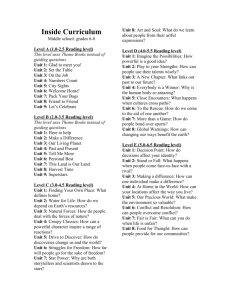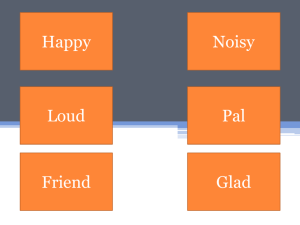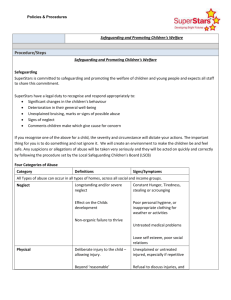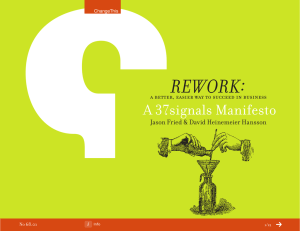5 Secrets Superstars
advertisement
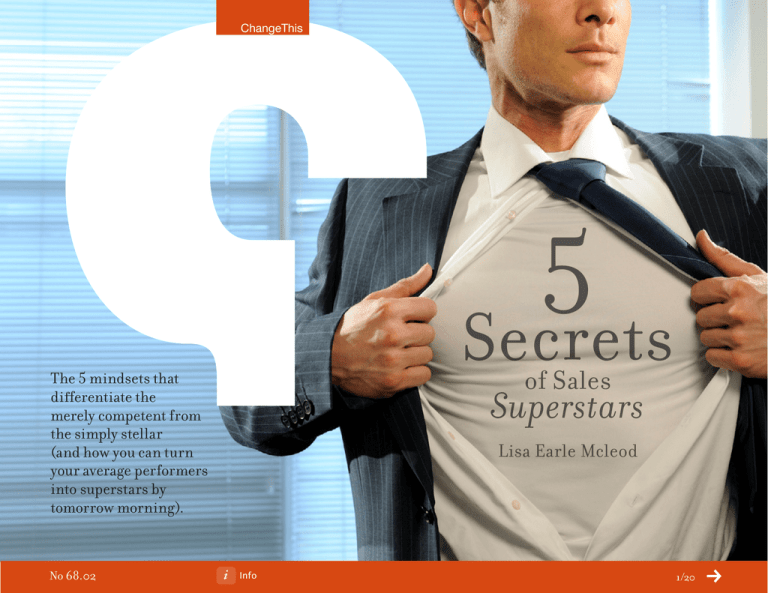
ChangeThis 5 Secrets of Sales The 5 mindsets that differentiate the merely competent from the simply stellar (and how you can turn your average performers into superstars by tomorrow morning). No 68.02 Superstars Lisa Earle Mcleod Info 1/20 ChangeThis What differentiates the great ones? What makes some people superstars, while most of their peers hover near the mediocre middle? It’s not too hard to pinpoint the difference between average performers and poor ones. Easy to spot skills like work habits, product knowledge, communication style and use of sales tools are all indicators of general competence. The challenge for most organizations is not determining the difference between good and bad; it’s discerning the difference between good and great. Why are some sales people superstars, while other people in the same situation, selling the same stuff to the same customers experience a much lower rate of success? It’s a question every CEO and VP of Sales wants to answer. Is it better call planning, more questions, a thorough understanding of the customers, more sales activity? Organizations have been trying to crack the code of sales success ever since the first stone salesman hit the road with a sample case of rocks. What’s the difference between merely competent and simply stellar? And is it possible to turn average performers into great ones? The answer is yes. I’ve been studying sales people for over twenty years. I’ve coached the best of the best, and spent many long hours training the not-so-fabulous. No 68.02 Info 2/20 ChangeThis I’ve witnessed everything from the awful to the amazing. I’ve ridden alongside reps who bombed every call seemingly oblivious to the fact that their customers couldn’t wait for them to leave. I’ve also observed presentations where the clients walked in convinced they were only going to give the presenter a token 5 minutes before telling them no thanks. Yet thirty minutes later, they’re eagerly supporting a potential multi-million dollar deal, simply because of the way the information was presented. After two decades of studying thousands of interactions, and doing extensive interviews with hundreds of sales people and customers across a variety of industries, I can tell you there are distinct differences between the superstars and their more mediocre counterparts. The differences are subtle. But they’re also very real, and they show up in the numbers. But it’s not just about what the superstars do differently, it’s about the way they think. They approach their jobs with a totally different mindset than their average performing counterparts and it plays out in every aspect of their interactions. It’s not just about what the superstars do differently, it’s about the way they think. No 68.02 Info 3/20 ChangeThis Selling Skills: Art or Science? Albert Einstein once said, “We will not solve problems of today with the level of thinking that created them.” The mistake most organizations, and frankly, most sales training programs make is that they try to teach skills before addressing the mindset. Selling skills models, questioning techniques, call-planning worksheets, strategic roadmaps and the like are all helpful tools for improving sales performance, but they will only take you so far. If you truly want to create superstars (and what organization doesn’t want a team of superstars?) you have to get inside people’s heads and train them to think differently before you can expect them to act differently. The truth is, most people are capable of becoming superstars. The reason they’re not star performers now isn’t because they’ve made a personal commitment to mediocrity. It’s often because their leadership hasn’t provided them with any new thought-processes that might make them any better. Said another way, you can’t expect people to change their behavior until you teach them how to change their thoughts. Here are the five mindsets that separate the superstars from the rest of the pack and how you can teach everyone in your organization to embrace them: No 68.02 Info 4/20 ChangeThis i. superstars hold two agendas in their mind at the same time Average performers tend to approach their interactions focused exclusively on their own goals. Superstars on the other hand, go into situations focused on their goals AND the goals of the other person. This seemingly nuanced difference in thinking is the single biggest differentiator between the superstars and their more average counterparts. It might seem murky, but it’s not. It’s a dramatically different mindset that affects every element of the sales process. You can’t expect people to change their behavior until you teach them how to change their thoughts. For example, most sales people know that they’re supposed to ask questions. Mediocre sales people will tell you that the purpose of questions is to uncover customers’ needs. But if you listen closely to the types of questions they usually ask you’ll hear that they aren’t asking questions about the customer at all, they’re just fishing for quick opportunities to close the sale. Questions like “What are you looking for in a vendor?” or “What do you like about what you’re currently using?” aren’t really about trying to understand the customer’s agenda. They’re about furthering the sales person’s agenda. And customers can feel the difference. No 68.02 Info 5/20 ChangeThis Superstars come from a place of genuine interest. Because they consider the customer’s agenda just as important as their own, they ask more in-depth questions, like, “What are some of the biggest challenges you face in your job?” or “How do you think the changes in the economy are going to affect you in the coming year?” Instead of merely trying to uncover surface needs within the small context of their products, they uncover bigger picture customer objectives within the context of the entire situation. That’s why they’re able to close larger sales and hold onto the business longer. Superstars understand the customers’ true objectives (versus simplistic purchase requirements) so they can make a more compelling case for whatever they’re offering. F. Scott Fitzgerald said, “The test of a first rate intelligence is the ability to hold two opposed ideas in the mind at the same time, and still retain the ability to function.” Superstars exhibit higher level thinking because they don’t succumb to the either/or mind set that causes lesser performers to forget about the customer’s goals. They hold a space for both agendas. They embrace AND. They seamlessly assimilate their goals AND their customer’s goals into larger, more robust solutions. This enables them to close bigger deals, retain higher margins, create more customer loyalty and improve customer retention. The ability to Embrace AND takes some skill, but it’s a thought-process that can be taught. No 68.02 Info 6/20 ChangeThis Training Technique: Recast their thinking using visual anchors The reason average performers can’t simultaneously hold onto their agenda and the customer’s agenda at the same time is because they’re afraid that if they put their own agenda on pause, it will be lost. They might not be fully conscious of their own internal thought process, but after observing thousands of reps I can assure you, the reason they don’t fully focus on their customers is because they’re too worried about achieving their own agenda. Kind of ironic, isn’t it? Superstars exhibit higher level thinking because they don’t succumb to the either/or mind set ... The secret of changing their behavior is to change their thoughts. Either/or thinking is the default setting of the human brain (think turf wars and politics). Intellectually, sales people know they need to pay attention to the customer, but their brains keep getting in their way. So one of the techniques we use to help salespeople elevate their thinking is to provide them with a visual model. Our model, The Triangle of Truth, is easy to understand. Your truth is one side of the triangle, the customer’s truth is on the other side of the triangle. Your goal as a sales person is to create a higher-level solution at the top of the triangle, the apex. A solution that is built upon your truth (my products are great, you should buy them) AND the customer’s truth (we have goals and objectives for our own organization). Both sides are equally important and should be equally attended to. No 68.02 Info 7/20 ChangeThis A visual model serves several purposes: It provides them with a common touchstone. It forces them to use a different part of their brains (visual processing), which opens up more creative thought. And it’s an easy to remember tangible cue for reframing their thinking. Trying to tell a Type A that they should be a better listener and ask more questions is like your mom or Sunday School teacher telling you to be more kind. You know it’s true, but it’s hard to remember their advice in the heat of the moment, especially when money, an incentive trip to Aruba or your ego are at stake. We find that by using The Triangle of Truth model we can visually demonstrate how putting your own truth on pause in order to uncover the customer’s truth doesn’t make you less powerful; it makes you more powerful. Think about it. Who’s smarter, the salesperson who only understands their agenda or the sales person who knows their agenda AND the customer’s agenda? This logic appeals to even the most self-absorbed sellers, and it provides them with powerful way to solve the “my agenda vs. their agenda” quagmire. The Triangle of Truth isn’t a sales call model; it’s a thinking model that reps can use to reframe their thoughts at every stage of the sales cycle. The Triangle of Truth isn’t a sales call model; it’s a thinking model that reps can use to reframe their thoughts at every stage of the sales cycle. No 68.02 Info 8/20 ChangeThis Other techniques we use to help sales people better understand their customers’ “truths” include: spending a day in the life of a customer, identifying how their customers get evaluated and doing customer interviews where they aren’t allowed to talk about product. We also teach managers to focus on the quality of information the sales person gathers about their customers, not just their call outcomes. Most sales managers usually coach their sales people on call objectives, call results and, sometimes, the skills exhibited during customer interactions. But if you can go a step further and continually ask your sales people questions like: How do you think this person gets evaluated? What do they lie awake at night worrying about? What are the key measurements for success in their job? You’ll prompt them to think more deeply about their customers. These types of questions start a chain reaction. When your reps get the message that you expect them to understand the customer’s agenda, they start asking about it on sales calls. This engages them in more robust dialogues and it becomes impossible to ignore the fact that the customer has bigger objectives than their purchase needs. That information then prompts the reps to better connect with big picture customer goals, which in turn gets a better response from the customer. Once you help them start the process, it becomes self-reinforcing because the results are so positive. Being able to simultaneously embrace two agendas (the company’s AND customer’s) is the foundation for becoming a superstar. The other four superstar mindsets are built upon embracing AND. Average reps can master these mindsets, but they need coaching in order to step outside their comfort zone. No 68.02 Info 9/20 ChangeThis ii. superstars can sit with uncertainty Mediocre performers want things to go according to their script. They get anxious in the face of new information and they frequently try to close too early and too often. If you’ve ever suffered the gut-wrenching sales manager experience of watching your salesperson ignore customer cues and miss important information because they were so eager close the sale, you understand the perils of being too attached to a pre-scripted call plan. Superstars, on the other hand, are more confident. They know that they’ll ultimately be able to close the sale, but they’re not attached to having it play out in a certain way. To be clear, superstars are no less focused on making the sale than their counterparts; in fact, they’re usually more focused. But they’re not attached to having every interaction play out just so. The 1980’s “ABC: Always Be Closing” sales model hasn’t been effective since WKRP’s Herb Tarlick donated his plaid jacket to the Self-Absorbed Sales Person Hall of Fame. Superstars ... know that they’ll ultimately be able to close the sale, but they’re not attached to having it play out in a certain way. No 68.02 Info 10/20 ChangeThis Superstars know this. Their ability to sit with uncertainty represents a more sophisticated approach. It’s what enables them to freely explore new information rather than blowing past it in an attempt to close. This changes not only the feeling of their calls—customers feel heard and understood—it also changes the facts. When it’s time to close, the superstars have much more tangible information and are able to make a much more compelling case than their average counterparts. Average sales people often spend a lot of time dealing with objections and obstacles after they present their plans. They’re uncomfortable with the uncertainty of new information, so when potential obstacles surface, they frequently ignore anything that threatens to derail their pre-scripted pitch. In another ironic case of how trying-to-get-what-you-want too-quickly-keeps-you-from-getting-it-all, average performer’s sales cycles often stall and flounder. However, Superstars get potential obstacles on the table early. This allows them to deal with them proactively rather than reactively. They actually close deals faster because they’re not overly attached to making the sale in the first thirty seconds. Coaching Process: Start with the call plan The secret of helping salespeople sit with uncertainty is to subtly change the way they do pre-call planning. (Note: If your people sell something that costs over a few dollars and they aren’t doing any pre-call planning, you’re probably facing the challenge of trying to turn poor performers into good ones, but the technique still applies.) The shift you want to make here is to help them plan not just the end of the call (the magic moment when the customer buys or advances the sales cycle) but also the beginning of the interaction, which sets the tone and direction for the way the conversation will play out. No 68.02 Info 11/20 ChangeThis You want them to create call openings that engage the customer in an actual dialogue, versus call openings that are simply asking permission for the sales person to deliver a monologue. For example, an average rep will tell you that their call objective is to close the sale, so their call opening is often something along the lines of “I’d like to ask you a few questions about your accounting (or technology, or food service, or farm equipment, or widget) needs.” It’s an opening designed to get the customer to reveal a need so that the sales person can pounce. It allows no room for any dialogue outside the sales rep’s product area, and unless the customer has already decided they have a need, they’re unlikely to engage. Rather than simply asking for permission to make a pitch, a better call opening might be, “I know that a lot of people in your industry are concerned about how the economy will affect their business in the coming year. What impact do you think it will have on you and your organization?” When you ask average reps to plan more open-ended, customer-focused openings, they often respond with, “If I bring up something like that, who knows where the customer will go with it.” To which you say, “Exactly. If it’s in the front of the customers mind, we need to know about it, so that it can be at the front of our minds.” A good guideline for sales people is to break their calls in half. Whether they have six minutes or sixty, at least half of their interaction (preferably the first half) should be spent exploring the customer’s situation and environment. The more comfortable they get wading through the waters of uncertainty, the more skilled they will become at identifying bigger picture themes and pulling out relevant issues. Then it becomes a matter of how they connect the dots. No 68.02 Info 12/20 ChangeThis iii. superstars’ brains work backwards Mediocre salespeople think “I have this product, how can I sell it to this customer?” Superstars reverse it, they think ‘I have this customer, how might my product be helpful?” This seemingly backwards way of thinking shows up everywhere from the way superstars prep for their sales calls to the way they present their solutions. An average rep will tell you, “I’m going to talk about this product and how it compares to what you’re currently using.” However, superstars organize their conversations around the customer’s environment and objectives, not their product benefits. Average reps tend to say, “My widget does this and this, and here’s how it’s going to solve your problem.” When a superstar makes a presentation, they’re more likely to say, “You told me you have this goal, let’s talk about how we accomplish it.” Again, it’s a seemingly subtle, yet very distinct difference. This reverse ordering flies on the face of the traditional feature-benefit or feature-advantage-benefit style of selling so many of us were taught. Yet, while it may seem backwards to the average sales person who thinks product first, customer second, it’s not backwards to the customer at all, who thinks goal or problem first, solution second. Superstars ... think ‘I have this customer, how might my product be helpful?” No 68.02 Info 13/20 ChangeThis Management Modeling: Reverse the way you serve it up (yes, this means you Mr. & Ms. Marketing) If you want your sales force to present your offerings in a compelling way to their customers, then that’s the way need to serve it up. Leading with the features of your product or service isn’t compelling to anyone outside of the inner circle. Instead of opening your next meeting with a bells and whistles presentation about your new initiative, try opening with an overview of the most pressing issues facing your customers. Then tee up how your new product or initiative addresses those. If you want your sales force to present your offerings in a compelling way to their customers, then that’s the way need to serve it up. Warning, this reverse ordering can be a challenging sell with your marketing department. Typically the people who do customer research are fairly well acquainted with the issues and challenges going on inside the customer base. But what often happens, especially in large organizations, is that the people charged with creating sales aids and marketing materials are more feature-benefit focused. Their presentations and materials can often become endless diatribes extolling every single virtue anyone ever imagined the product or company could possibly possess. (Case in point, I once sat through a sixty-minute presentation on frozen orange juice.) No 68.02 Info 14/20 ChangeThis Superstars may be capable of translating generic feature dumps into meaningful customer calls to action. But most average performers can’t or won’t do the mental gymnastics required to reverse the ordering, connect it to a customer issue or goal, and then play it back in the customer’s language. So you have to do it for them. Instead of delivering a marketing message that says “we have great widgets, here are the fourteen features and the way they generically benefit the customer is X, Y and Z,” you (and your marketing team) need to provide salespeople with real examples of customer problems you’ve solved and a description of how you were able to solve them. This doesn’t mean glowing testimonials about how great you are. It means saying that A, B and C are the three most challenging issues for our customers. We help them solve A by doing this, we address B with this, and we help them achieve goal C by providing them this. Leading with examples of problems you’ve solved and goals you’ve helped customers meet sets the tone for the organization. It tells the sales force loud and clear, success is about helping customers, not just making quota. Which is exactly how superstars approach their jobs. No 68.02 Info 15/20 ChangeThis iv. superstars def ine success differently Average performers tend to view other people as either obstacles to or helpers in accomplishing their goals. They often use words like gatekeepers, blocker, competitive threat or supporters, defining others in the context of whether they’re going to help or hinder their sales efforts. Superstars have a different definition of success. Other people aren’t just a means to accomplish their goals; other people are their goal. Talk to any top performer and you’ll find that they’re incredibly focused on their goals; AND they’re also equally passionate about helping other people achieve theirs. Their vision of success isn’t just about themselves, it’s about creating success for everyone. They live and breathe to make a difference in the lives of other. So they make a proactive effort to figure out what success looks like for every person they encounter. That’s why they ask the receptionist how they can help her get the promotion she’s going for, rather than just badgering her to let them in to see her boss. And it’s why they ask their buyer what challenges they might face in implementing the new system rather than trying to just shove it in as quickly as possible. It’s also why their sales encounter less internal road bumps and have more internal buy-in. Superstars don’t just act like they care about their customers, they actually do. It’s not some lame line in the annual report, it’s the way they live their lives. No 68.02 Info 16/20 ChangeThis Leadership lesson: Connect with context (constantly) It’s natural for people to put their heads down and myopically focus on their own to-do’s. Most people are so overwhelmed with their own lives that trying to help others feels like a nice to have, not a must have. Superstars know that elevating others is the way you create success, and the more you do it, the more it circles back to you. Yet most people need frequent reminders of this universal truth. That’s where leadership comes in. One of the essential jobs of a leader is provide context and to ground people in a larger vision. For sales leadership, this means continually reminding the sales force of how their product or service affects people’s lives. You don’t have to cure cancer or sell calorie free pasta to make a difference. One of our clients sells technical support services. We created a webinar for them spotlighting what happens to a business when the server goes down. This reminds the sales force that losing data can cause a business owner to want to jump out the window, and it reinforces the message that they don’t just sell technical services, they sell sanity and peace. Another client of ours provides home care services for the elderly. The message we trained their franchise owners to adopt is “We help people improve their relationships with their parents and we provide seniors with the dignity and respect they deserve.” In our company we say, “we don’t just sell training and consulting, we’re creating world peace because we change the way people relate to their fellow humans.” It’s all about how management frames things up. People are desperate to be part of something bigger than themselves. When you put their work into a meaningful context, you tap into their deepest yearnings of their souls. And isn’t that what every company really wants? People who show up for work with their heart and soul? No 68.02 Info 17/20 ChangeThis v. superstars show up with love There are basically only two emotions: love and fear. They play out the same way at work as they do in our personal lives. Love expands, fear contracts. Mediocre performers might not be quaking in their boots every minute of the day, but they spend a lot of time worrying about whether or not things will go their way. This unspoken fear creates an emotional wall between them and their customers. Superstars have no such barrier. When they’re with you, they’re fully with you. It’s like the difference between a parent or teacher who is just putting in their hours, versus someone who is truly on fire to help you learn. One is showing up with love, the other is distracted by unspoken fears and worries. Some people are uncomfortable talking about love in the context of business. We want our customers to love our products, we want the market to love our company, and we want our employees to love their jobs. But we rarely talk about how we as individuals can put more love into the equation. But after studying the superstars, I can tell you, they show up with love, and they’re not the least bit embarrassed about it. Which leads me to the last leadership lesson. No 68.02 Info 18/20 ChangeThis Management Mantra: It’s okay to Get Emotional We’ve been told emotions don’t belong at work. But this it total bunk. If you want to create a passionate sales force and passionate customers, how do you expect to do it without engaging on an emotional level? If you want customers to love your sales people, and you want your sales people to love their jobs, you as a leader are the one who needs to start the process. Showing up with love means being willing to put your heart on the line for your team. It means being willing to get misty eyed when you talk about your people. It means showing your customers that you care enough about them to ask questions and actually listen. And it means not trying to pretend that you know everything or that your agenda is the only one that counts. Loving your customers and loving your collogues is just the same as loving your family or loving your spouse. You can’t expect to get love back, unless you’re willing to put some in. The superstars of work and life know that when you care about other people and you show up with love, everything changes. So be the hero, be the leader, and have the courage to show up with love. Somebody has to be the superstar; it might as well be you. No 68.02 Info 19/20 ChangeThis info About the Author Lisa Earle McLeod is an author, columnist, keynote speaker and business consultant. The founder and principal of McLeod & More, Inc, she specializes in sales and leadership training. Her newest book, The Triangle of Truth, has been cited as the blueprint for “how smart people can get better at everything.” Visit TriangleofTruth.com for a short video intro. send this Pass along a copy of this manifesto to others. Subscribe Sign up for our free e-newsletter to learn about our latest manifestos as soon as they are available. buy the book Get more details or buy a copy of Lisa Earle McLeod’s The Triangle of Truth. Born on date This document was created on March 3, 2010 and is based on the best information available at that time. Check here for updates. ABOUT CHANGETHIS Copyright info WHAT YOU CAN DO ChangeThis is a vehicle, not a publisher. We make it easy for big ideas to spread. While the authors we work with are responsible for their own work, they don’t necessarily agree with everything available in ChangeThis format. But you knew that already. The copyright of this work belongs to the author, who is solely responsible for the content. You are given the unlimited right to print this manifesto and to distribute it electronically (via email, your website, or any other means). You can print out pages and put them in your favorite coffee shop’s windows or your doctor’s waiting room. You can transcribe the author’s words onto the sidewalk, or you can hand out copies to everyone you meet. You may not alter this manifesto in any way, though, and you may not charge for it. ChangeThis is supported by the love and tender care of 800-CEO-READ. Visit us at 800-CEO-READ or at our daily blog. No 68.02 Info This work is licensed under the Creative Commons Attribution-NonCommercialNoDerivs License. To view a copy of this license, visit Creative Commons or send a letter to Creative Commons, 559 Nathan Abbott Way, Stanford, California 94305, USA. Cover image from iStockphoto® 20/20
